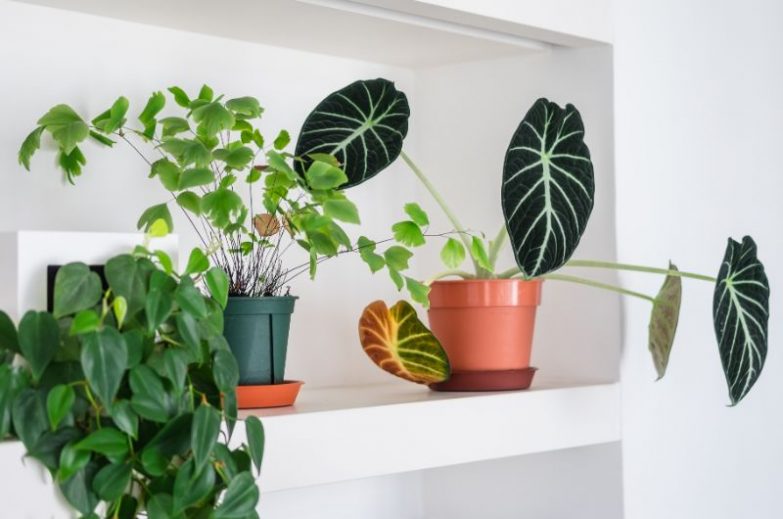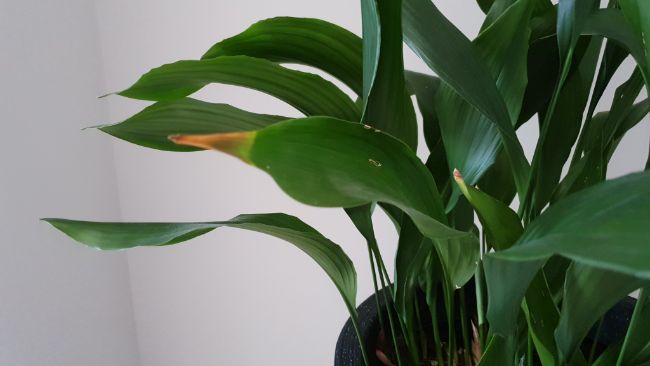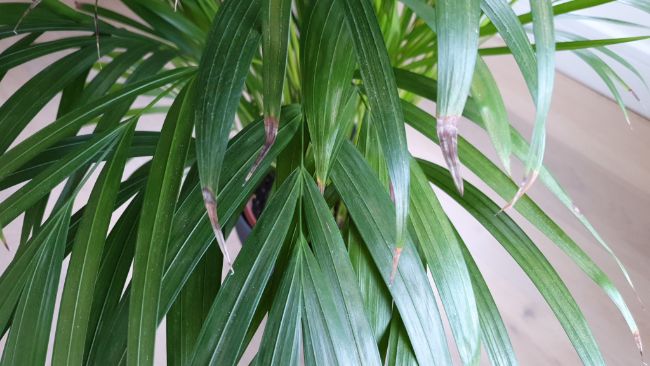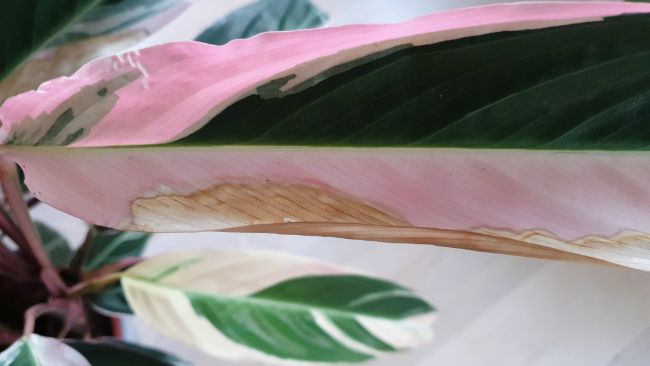Growing houseplants can be such a joy, but it is a challenge keeping them looking vibrant and healthy all the time. Whether you are a new plant owner, or an experienced gardener, one of the most common questions people have is why do indoor plant leaves turn brown? Thankfully, it’s not hard to work out why this is happening and take steps to reduce and prevent it.
Why do indoor plant leaves turn brown? There are many reasons why the leaves on your indoor plants may turn brown: improper watering, fertilizing, or transplant shock; environmental causes due to lighting, heat, drafts, or humidity; pest or disease issues; and natural causes such as acclimatization or age.
To determine why your plant leaves are turning brown it’s important to first pinpoint exactly where on the plant the problem is occurring, and get a better understanding of the following basic causes. Then you can try to solve the problem.
Different Patterns Of Brown Leaves On Indoor Plants
Take a look at your plant for a minute. Is the brown showing up on the leaves in a specific pattern? In most cases the brown patterns will appear in a very distinct pattern, helping to give you clues about why the leaves are turning brown.
Brown Leaf Tips
Where? In this case, the very tips of the leaves darken and dry out, appearing brown and papery. They may crumble and fall off when touched.
Why? Brown leaf tips are one of the most common problems seen in indoor plants and are usually related to water or fertilizer problems.
How? Ideally, water is taken into the roots from the soil and is moved upwards through the plant until it reaches the leaves, where it is then used in photosynthesis or lost due to transpiration or evaporation. If there isn’t enough water in the soil or something halts the process of water moving through the plant the leaf tips turn brown since they are last in line to receive water.
Brown Patches Or Spots On The Leaves
Where? This occurs in random spots across the leaves, sometimes forming in circles that appear to grow over time or undefined shapes. If left untreated the patches or spots can fill the entire leaf surface.
Why? Brown patches or spots on the leaves are usually related to fungal disease or insect pests.
How? Insects or diseases may attack a localized spot on the leaf, causing the tissue to die and turn brown.
Entirely Brown Leaves
Where? At times the entire leaf will begin by morphing into a yellow color, and then turn brown and dry out, after which it may fall off the plant completely. It usually happens to lower leaves on the plant but may occur through the middle or at the top, depending on the cause.
Why? Entirely brown leaves are usually a natural part of the plant’s growth and aging process, unrelated to the care of the plant.
How? Plant hormones within the cells trigger leaves to begin dying and turn brown.
Reasons Why Indoor Plant Leaves Turn Brown
Brown leaves may appear on your plants for a variety of reasons, some of them based upon the care you’re giving the plant, some upon environmental conditions, as well as pests and diseases. Brown leaves may also appear naturally and this isn’t a cause for concern. This is partly why it’s important to determine what the cause is before trying to remedy it.
Care
Improper care is the most common reason why indoor plant leaves turn brown and should be the first thing you investigate.
Watering
Water is a critical aspect of healthy plant growth since it’s used in photosynthesis to create food for the plant. With houseplants though, you have to give them the correct amount of water; both underwatering and overwatering cause major problems.
- Under-watering: In many cases, you’ll see brown leaf tips on your plants because you’re not watering enough. As mentioned above, water is constantly moving through the plant. If there isn’t enough water in the soil, what is there will be taken into the roots and used up by the plant before it can reach the tips of the leaves, causing them to turn brown.
- Over-watering: Just as too little water is a big problem for plants, giving them too much can be just as problematic. When plants are overwatered it pushes the air out of the soil, filling all the pore space with water. Without oxygen, your plant will in essence drown and the leaves will start turning brown as they perish. Over-watering can also lead to problems with root rot, a fungal disease that results in brown, mushy leaves.
How To Fix Watering Problems?
The key to fixing watering problems, and preventing them in the future is to know exactly how much water your plants need and then follow an appropriate watering regime. Some plants prefer their soil to be moist at all times, and others like the soil to dry out slightly before they are given more water.
Use your index finger to check soil moisture levels, and only water once the soil has dried out an appropriate amount for the plant you are growing. Then water thoroughly until excess water drains out the bottom of the container.
Read my article about how to tell when your indoor plants need water. This article provides some great tips to avoid overwatering and underwatering, making growing healthy, vibrant houseplants so much easier.
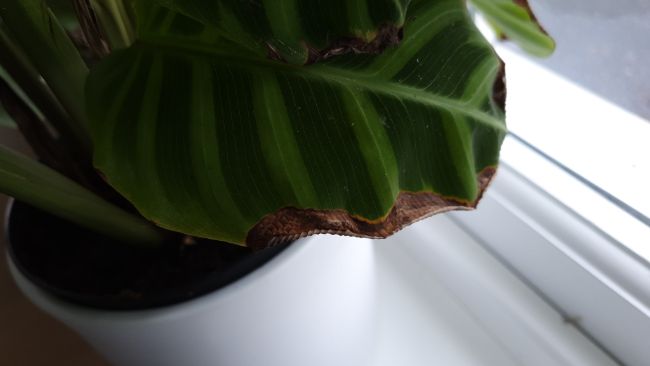
Nutrient Problems
All plants have nutrients that are essential for their growth; without them, the health of the plant will be affected, depending on the nutrient(s) lacking.
Over time these nutrients are naturally depleted from the soil (whether you’re using garden soil or soilless potting mix) and need to be given to the plant in the form of fertilizers. Just like water though, it’s important to give your plant the correct amount of fertilizer to prevent problems.
- Under-fertilizing: Too little fertilizer leads to a lack of sufficient nutrients. In an attempt to maximize growth based upon too little “food”, plant hormones will trigger older leaves to die (i.e. turn brown) and fall off so all of the limited resources can be directed to the younger parts of the plant. It’s self-preservation, in plant form.
- Over-fertilizing: Behind problems with watering, giving your plant too much fertilizer is the second leading cause of brown leaf tips. This is because of a condition known as fertilizer burn. Fertilizers contain salts that may build up in the soil over time, especially if you are over-fertilizing. This accumulation of salt can either hold water in the soil, keeping it from going into the plant’s roots, or the salts may directly damage roots and hinder water uptake.
How To Fix Nutrient Problems?
The best way to remedy problems with nutrient levels is to use an appropriate fertilizer, and then use it according to the directions printed on the package label. Read my guide to fertilizing indoor plants for more information.
There isn’t any need to fertilizer more often than the manufacturer recommends. Also, during the cooler months of autumn and winter, plant growth slows making it necessary to scale fertilizer application back, if not stop fertilizing altogether.
If salt buildup is a concern, and the reason for brown leaf tips, you need to thoroughly flush the buildup out of the soil. Place your plants in the sink or bathtub and water them with distilled water until the water freely flows out of the bottom of the container.
Environmental
The environment within your home is different than the natural conditions your plants are historically accustomed to, and this climate can make your indoor plant leaves turn brown.
Light
Plants are specific in their light needs, ranging from those that need full-sun conditions to those that may thrive in partial to full shade. When exposed to too much direct sun or when they don’t receive enough sunlight exposure leaves may turn brown as the plant struggles to grow.
How To Fix Light Problems
Check online or with a local nursery or garden center to determine the sunlight requirements for your specific plants. If plants aren’t receiving the right amount of light first try moving them to a different location within your home.
Plants getting too much sun can also be moved further away from a window as the light intensity drops significantly; plants not getting enough may benefit from supplement lighting provided by grow lights.
Temperature
Most houseplants are well suited for the temperature within your home; it is often said that if you are comfortable, your plant will be too. However, extreme fluctuations in temp can cause stress to your plant, resulting in the leaves turning brown.
How To Fix Temperature Problems
Make sure your plant isn’t in a spot where it may experience cold drafts from windows or doors or is directly affected by the air coming from your vents. This means both the heat emitted from a furnace or the cold given off by an air-conditioning system.
Humidity
The relative humidity inside our homes is typically less than what is found outdoors – especially in the cold, drier, winter months – and houseplants may show signs of brown leaf tips when the moisture is too low.
How To Fix Humidity Problems
Increasing the humidity level for your plants is a fairly easy thing to do. You can periodically mist the leaves of your plant using a spray bottle, you can group plants together (this creates a localized area of higher humidity), or you can set your plants in a pebble tray that holds standing water.
Read my article which covers some of the best ways to increase humidity for your plants for more information.
Pests And Diseases
Problems with insect pests and diseases aren’t as common with indoor houseplants as outside plants, but they still do occur and may result in the leaves turning brown in localized spots or patches.
- Insects: Brown spots on leaves occurs when plants are infested with insects such as scale, mealybugs, spider mites, and aphids. These insects may attach themselves to your leaves, feeding on the water and sugars within the plant tissues; this causes brown “lesions” at the site of attachment.
- Diseases: Fungal diseases can cause brown spots on leaves too, as the fungus attacks a localized spot on a leaf (usually where water is allowed to sit on a leaf, or there is wound on the leaf surface) causing the cells to die and turn brown. Root rot, from overwatering, is a common fungal disease in houseplants that occurs when soil-borne fungi proliferate due to over-watering, damaging the roots and inhibiting water uptake into the plant.
How To Fix Pest And Disease Problems
The most important thing in fixing these problems is to continuously check your plants for insect infestation or diseases and then treat them quickly.
If you are experiencing insect problems, there are a range of treatment options, from meticulously picking insects off by hand, to using insecticidal soap to treat the plant. Read my guide to identifying, treating and preventing common houseplant pests for more information.
When fungal problems arise you can try to treat with a recommended fungicide, although it may be easier to remove any diseased tissue and promptly discard it.
Natural Causes Of Indoor Plant Leaves Turning Brown
Lastly, let’s touch quickly on the natural causes that may turn your indoor plant leaves brown.
- Acclimatization: Sometimes its necessary to move plants to a new location or to repot them into a new container. This change in conditions may put your plant into shock, even if you try to acclimate it slowly, causing entire leaves to turn brown and then fall off.
- Aging: As your plant grows and matures, it is natural for older leaves to entirely turn brown and then fall off. In some cases, this is because your plant is trying to grow into a specimen with a taller stem, so it sheds the lower leaves as it grows taller. Leaves will also turn brown and fall off so the plant can direct its limited resources to new leaves, fostering their growth.
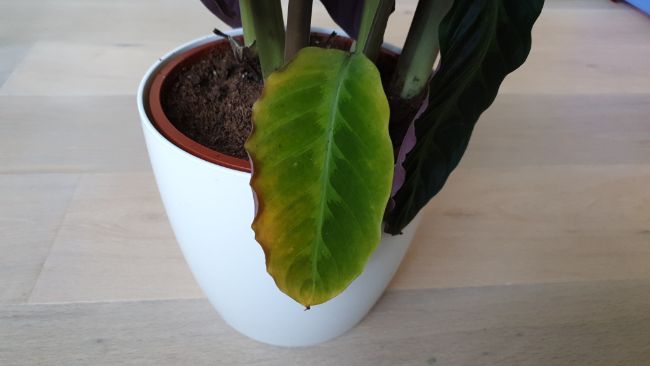
How To Fix Acclimatization And Aging Problems
Unlike the other causes, there isn’t any way to fix this or prevent it from happening since it is a natural process. Acclimatization can take from a few weeks to a few months. Just focus on providing good care conditions during this time to help the plant adapt to its new environment.
Removing Brown Leaves From Indoor Plants
When your indoor plant leaves turn brown, it can be a little disheartening. Once the problem occurs you can’t repair that brown, dead leaf tissue. The only solution is to remove the unsightly leaves.
To remove brown leaves you’ll need to start by finding a pair of scissors that are quite sharp. Sharp blades minimize damage to healthy plant cells in the leaves, reducing the energy the plant must expend to heal the open wound.
Before using your scissors, wipe them down with rubbing alcohol. This cleans and sanitizes the scissors, reducing the risk of transmitting problems from plant to plant.
Depending on the extent of the brown on the leaves you can either remove the entire leaf or just trim off the brown tips.
- If you are removing the entire leaf, use your scissors to cut the leaf all the way back to the main stem of the plant, or down to the soil surface depending on the plant type.
- To trim off the brown leaf tips, use your scissors and either cut straight across the leaf tip to remove the dead tissue or make angled cuts to replicate the shape of the leaf tip.

